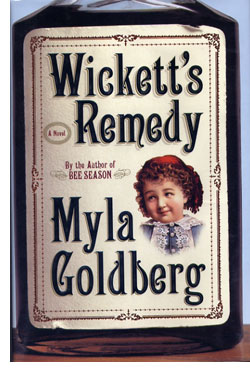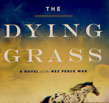 |
 |
 Myla Goldberg
Myla Goldberg
Wickett's Remedy
Reviewed by: Rick Kleffel © 2005
Doubleday / Random House
USA Trade Hardcover, First Edition
ISBN 0-385-51324-0
Publication Date: 09-020-2005
326 pages, $24.95
Date Reviewed: 10-29-2005
Index:
General Fiction
Science Fiction
Lydia Wickett, neé Kilkenny, the heroine of Myla Goldberg's new novel,
'Wickett's Remedy', is a "Southie", an Irish lass from the bad part
of Boston. When she meets the sweet but very shy Henry Wickett while working
at Gilchrist's, a department store, he's in medical school. But wouldn’t
you know it; soon after they marry he drops out, and instead decides to dedicate
his energies to creating a patent medicine he calls "Wickett's Remedy",
in reality a sweet concoction flavored by Lydia. Henry intends the letters
that he sends those who buy the medicine to be the real remedy that he provides.
His home-brewed literature will be the balm to cure his customers' ills.
'Wickett's Remedy' is no balm to cure our ills. It's a tart, terse and tense
story about memory, the myths of our lives, the 1918 flu pandemic, growing
old, economic disparity, certainty and doubt. In a remarkably concise novel,
Goldberg covers a lot of territory and packs in a multitude of ideas. She manages
this by virtue of an adventurous format, a very low-key and accessible use
of experimental styles thoroughly integrated into the narrative. The result
is a novel that is page-turningly easy-to-read, but filled with thought-provoking
themes. In some ways reminiscent of an almanac, 'Wickett's Remedy' is entertainingly
filled with choice bits of unexpected dialogue, news reports and correspondence.
From the get-go, there's something strange happening in the margins of the
novel. The pages of 'Wickett's Remedy' sport an unusual design. The main narrative
uses about 3/4 of the standard page width, leaving a wide margin within
which Goldberg inserts comments on the main narrative. For example, on the
first page, readers will find Lydia's recollection of the sound of dray horses
and in the margins Lydia's mother's recollection of Lydia's description. The
two stories are not exactly congruent. What’s immediately clear is that
not everybody remembers the same details from the same events.
Details and memory are the stuff with which we build our lives in our own minds,
in much the same way that a novelist builds a novel with third-person narration.
Goldberg's core novel, the story of Lydia Wickett as she endures the twin terrors
of the World War I and the 1918 flu pandemic, is told with the kind of transparent
prose that flows effortlessly and gorgeously into the reader's mind. But that's
not all that readers will find here. Unfolding in the present is the story
of QD soda, the distant descendent of Wickett's Remedy, and the man who created
that flavor while working with Lydia and Henry.
Besides the margin notes from an increasing variety of contributors and contemporaries
who take issue with Lydia's recollections, readers will find embedded within
the narrative period news stories and advertisements, as well as letters from
other characters and snippets of overheard conversations. Goldberg expertly
layers her material, revealing the mystery that lies at the heart of the novel.
The variety of sources makes the book easy to read and entertaining, but there's
a cumulative effect of all the details that Goldberg accumulates. Everything
in this novel is there for reasons that are quite satisfyingly revealed.
Goldberg develops a number of themes, including a vision of life after death
that is wonderfully original, makes sense and offers her a unique angle on
the many deaths in the novel. After all, her subject is the pandemic that killed
more humans than all the World Wars combined. That's a lot of death, but in
spite of this Goldberg never gets even slightly close to pathos. Everything
occurs in prose that seems well-lit and crisply written. Even when she's writing
about the actual experiments that the United States government performed on
Gallup Island, in which prison inmates were deliberately infected, she manages
to seem cheerful and upbeat. Goldberg's ability to pull this off does not diminish
the impact. It just makes it easier for the readers to assimilate the magnitude
of the pandemic and its effect on America.
One of the more chilling aspects of this novel is Goldberg's unflinching
portrait of primitive science that thinks itself nearly omnipotent. As the
doctors, nurses and hawkers of miracle cures explain their reasoning with certitude,
the reader is constantly aware of just how wrong they are. Goldberg's ability
to layer these skewed perspectives -- the characters who are certain their
science is right and the readers who know the science is wrong -- give the
novel the feel of a science-fiction thriller set in the past. It's almost
as if H. G. Wells had penned a novel chock full of optimistic visions
of the power of medical science, based on extremely flawed medical science.
The publishers and book design here certainly deserve some credit. It must
have been very tempting to put all different parts into different typefaces,
to turn this novel into a full-on cut-and-paste extravaganza. But the design
is very calm, which accomplishes two goals. It makes the novel a lot easier
to read, and it draws in all the disparate parts into a more coherent feeling
whole.
Another effective aspect of this novel is the editing. Given the wide range
of stories and themes covered, this novel could easily have been twice as long.
It's to Goldberg's credit that she managed to pare it down into the narrative
we have before us. And it's even more impressive that the work contains so
many interesting, intricate fully-finished stories that emerge across the entire
variety of narratives included here. The story of Quentin Driscoll is poignant,
powerful and plays out mainly in the ancillary materials.
'Wickett's Remedy' is in the end a demonstration of how a talented mainstream
writer can include the full spectrum of experimental literary techniques to
enhance and enrich a story without diffusing it. Goldberg's use of found articles,
imagined correspondence and the margin notes give her word-for-word more punch
and more power that she could have possibly got unfurling those same facts
and characters in a more traditional narrative style. She's a consummate literary
tool-user, a master craftswoman with the talent to pick up any literary device
she feels necessary and the intelligence to use these tools to tell a gripping
story.
|
 |
|
|
 |
| |
Review Archive
All Reviews alphabetized by author.
General Fiction
Non-Genre, general fiction and literature.
Horror
Supernatural fiction, supernatural horror and non-supernatural horror.
Science Fiction
Science fiction, science fantasy, speculative fiction, alternate history.
Fantasy
Fantasy, surrealism and magic realism.
Mystery
Crime, thrillers, mystery, suspense.
Non-Fiction
Non-Fiction, True Crime, Forteana, Reference.
Poetry
|
|
 |
|




